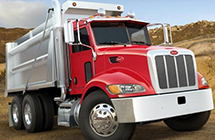 |
 |
|
| eNews • July 2016 | ||
| Promoting a Cost-Effective, Reliable and Competitive Transportation System |
||
 US truck orders plunge, driver retention improves on soft freight demand
US truck orders plunge, driver retention improves on soft freight demand
The soft U.S. freight economy has trucking companies slamming on the capacity brakes, sending orders of new rigs to a four-year low, but making it easier for them to keep drivers hauling for them.
Class 8 truck orders plunged 34 percent year-over-year in June to the lowest monthly total since July 2012 and the worst June since 2009, according to the transportation research firm FTR. Meanwhile, turnover at large truckload fleets fell 13 points in the first quarter to 89 percent, the American Trucking Associations reported.
Although North American surface freight shipments have continued to climb in recent months, they are still well below those of the last several years. Surface freight shipments in May were the highest they have been all year, rising 1.3 percent from April on the Cass Freight Index. Nevertheless, it was still 5.8 percent below May 2015 levels and 7 percent lower than levels in May 2014.
Meanwhile, the U.S. Department of Transportation and Bureau of Transportation Statistics’ Transportation Service Index for freight hit 121.1 in April, the most recent month for the statistic, down less than 1 percent after climbing - sometimes by leaps and bounds - for five consecutive years prior.
Carriers are in a “wait-and-see mode” before adding or replacing units thanks to the soft freight economy, according to Don Ake, vice president of commercial vehicles at FTR.
“The Class 8 market is stuck in a holding pattern,” Ake said. “Fleets are cautious as freight demand has cooled off this year.”
And FTR expects Class 8 orders - and the freight economy, for that matter - to remain tepid through the summer months.
“This is what the summer looks like in a market down cycle, so we can expect this level of activity for a couple more months,” Ake said.
The down market has also been reflected in job turnover rates at small and large carriers, according to the American Trucking Associations.
Turnover at large truckload fleets has fallen to its lowest levels since the second quarter of 2015, the nation’s largest trucking industry lobbying group reported. At smaller fleets - carriers with less than $30 million in annual revenue - turnover dipped 1 percentage point to 88 percent, the lowest figure since the third quarter of 2015, the group said.
“While still fairly high, the decline in turnover is reflective of the softening in the freight economy during the first quarter,” Bob Costello, ATA chief economist, said in a statement.
In trucking, declining freight demand has pressured carrier revenue and margins for the past three quarters. How much pressure, though, has depended on just how closely a trucking company was tied to manufacturing. High inventories also depressed freight demand, extending replenishment cycles.
In spite of this, many regional less-than-truckload carriers have been building terminals, expanding into new territories and adding customers as they have been able to win market share, hitting capacity ceilings in core markets and looking to expand into new ones.
Mentions of a recession-like environment from top transportation executives and lackluster growth in domestic and international freight volumes have fueled fears that if a freight recession is indeed upon the industry, it could be harbinger of something even worse: an outright economic recession.
However, ATA and FTR suggested there is a market rebound in the making for the second half of 2016. Such a bounce back would give a boost to the transportation industry, as well as the vehicle orders and turnover rates that reflect industry health.
“We do anticipate higher orders later this year,” Ake said.
“Should the freight economy witness an uptick during the second half of the year, we should see both turnover and demand for drivers rise as well,” Costello added.
Both men, though, did question just how strong of a rebound it will be, adding that the strength of the recovery will be in mirrored in the numbers.
“The volume of orders will be determined by the strength of the economy and freight activity at that time,” Ake said.
Source: Journal of Commerce
Soy Transportation Coalition |
|
